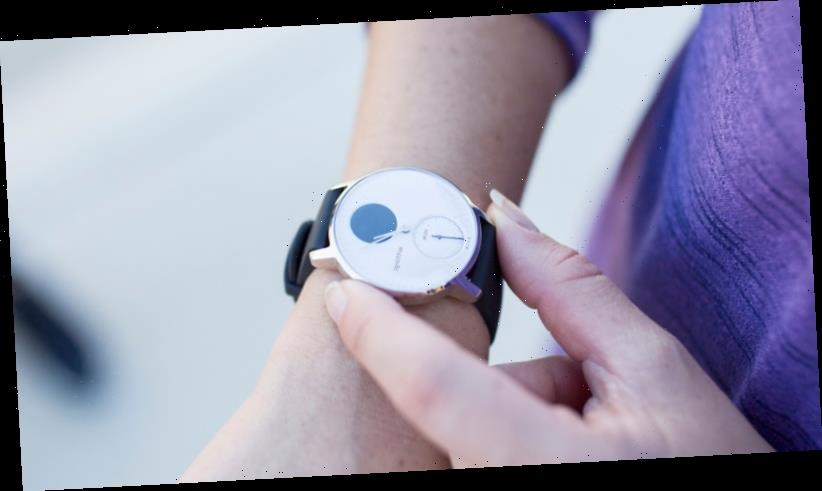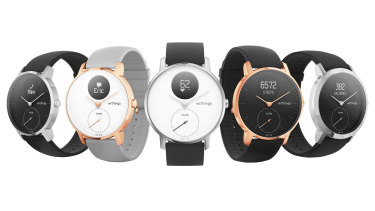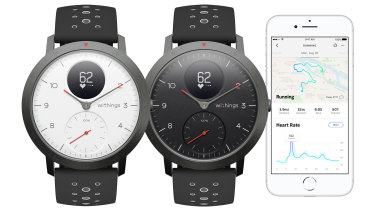Blending traditional looks and functionality with smart sensors and software, Withings' hybrid watches provide much of the benefit of smart gadgets with a fraction of the fiddling and huge battery life, as long as you don't mind the relatively modest feature set.
The French company, which was briefly known by the name Nokia Health, has a long history in connected health gadgets; also making blood pressure monitors, thermometers and scales. But its latest hybrid smartwatches — the Steel HR and Steel HR Sport — provide a compelling alternative to watches from Apple, Samsung and others thanks to a focus on background tracking rather than touchscreen computing.
The Steel HR looks mostly like an analogue watch, but with a tiny screen that turns on when you get a notification, are tracking exercise or want to check your stats.
The $300 Steel HR is a round 36mm watch that looks at first glance like a standard analogue timepiece. It comes with a black or white face and gold or silver case, with matching metallic hands and a silicon strap that's comfy and replaceable thanks to its standard pins and 20mm size. But the watch's upper complication is actually a monochrome LCD display, while the lower uses a physical dial to indicate your progress towards your daily step goal.
The watch connects to your phone via Bluetooth and sends data on your daily steps, heart rate, sleep quality and more to be logged in Withing's Health Mate app. You can also optionally import or export data to and from a range of apps including Google, Samsung and Apple's health services, which makes it easy to integrate into your existing routine. Otherwise the app is slick and easy to use, displaying your data in readable charts and offering encouragement and educational articles if you opt in to its various programs.
The Steel HR has a single button which you can press to cycle through various screens on the tiny LCD, including a step count, your current heart rate or your distance travelled today. You use the app to choose which screens should be included. It's true that on many smartwatches you can have all this information displayed screen at the same time with just a turn of the wrist, but the advantage here is that the battery life lasts for weeks (Withings says up to 25 days, depending on how often you work out).
As a watch for daily wear the Steel HR looks nice and, obviously, tells the time. But you can also have it vibrate when your phone gets a notification or call, and the caller's name or app icon and notification text will scroll across the LCD for a few seconds. You'll want to set it so only notifications from important apps make it through, but the system works well and makes it so I can keep working or walking and just glance at my wrist to see if a buzz is worth grabbing my phone for, which honestly is 90 per cent of the reason I like to wear a smartwatch.
The Steel HR Sport offers the same functionality with a different look and added oxygen uptake measurement.
Activity tracking kicks in automatically if the watch detects you walking briskly, running or swimming (it's rated up to 50 metres), and will report your results to the app. You can also start workout mode by holding the button and choosing from one of around 30 support sports and activities (you use the app to choose five for your watch to remember, so you don't have to scroll past equestrian and windsurfing every time). There's no on-board GPS so if you want map and pace data for running or biking you need to keep your phone on you.
Sleep tracking is also automatic, if you don't mind sleeping with your watch on, and you can also set a silent alarm that vibrates during the optimal sleep cycle for an easy wake up. With both sleep and workouts, results are logged in a timeline on the app alongside heart and step data, so you can check it at a glance or dive in and compare over time.
I've been using the watch alongside a $179 Withings Body+ smart scale, which keeps track of your weight and a range of other stats. It uses body mass index to calculate your ideal weight based on your height, and bioelectrical impedance analysis to calculate how much of your weight is fat, muscle and bone. These are far from perfect methods and in any event body measurement tech should always be used with a degree of caution, but I was impressed with how the watch and scales integrated together using the app.
For example when you step on the scale it weighs you before displaying a series of stats and measurement screens you decide using the app, and you can choose to include steps information collected from your watch. Once all the data's on your phone you could also compare your workout information with an increase in muscle mass or a decrease in weight. Programs work across devices too, for example my wife opted into the pregnancy program which offers insights via the app, adjusts feedback on weightgain and also disables many of the measurements from the scales.
Overall the Steel HR watch is a flexible low-key activity tracker in a nice anti-gadget package. I loved not having to deal with the touchscreen fiddling and constant charging of a smartwatch, the options for sleep and weight tracking (with the addition of a scale) is great and I only occassionally missed not having more data available on my wrist. The addition of a weather forecast option in the watch's screen menu would go a long way to addressing that. For an extra $30 you can get the Steel HR Sport with a larger face, more rugged look, ventilated band and VO2 max estimation so the app can give you a fitness level assessment after workouts.
Source: Read Full Article


